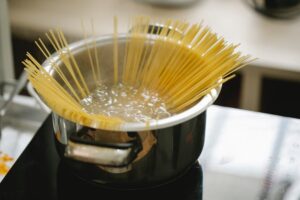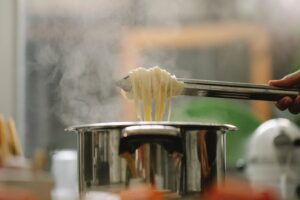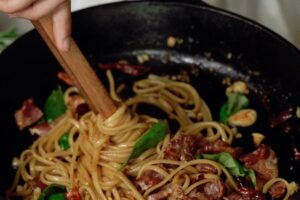When boiling pasta, sometimes the individual strands stick together. It happens to the best of us. However, having your pasta piled up in a giant mound on the plate before you can be off-putting.

If this happens, you don’t have to toss your dinner in the trash. This is your simple guide to unsticking your pasta so you can enjoy it without the clumpiness.
Easy Ways to Unstick Your Pasta
There are different reasons why pasta sticks together when you cook them. Pasta would often stick together primarily because of the combination of starch and moisture.
When you cook pasta, it releases starch into the boiling water. The starches on the surface would absorb water and become sticky quickly.
Also, if you allow your pasta to sit for too long without eating or refrigerating, it can stick together. The starches dry and the individual strands or pieces bond together.
If your pasta is stuck together or clumped, here are some steps you can take to unstick it.
These are techniques to quickly address the dilemma when you discover that your pasta is stuck together. This way, you can salvage it and make it enjoyable to eat.
Act Quickly
As soon as you finish cooking your pasta, you need to act quickly to prevent it from sticking together. The most important thing to note is to be swift about separating it.
In a pot, bring the water to a boil. Make sure once or twice you stir in the pasta after adding it. To separate the noodles, use a fork. Cook the pasta until it’s thoroughly cooked.
Remember that the longer the strands remain stuck, the harder it might be to separate.
Use a Fork or Tongs to Unstick Them
Get a fork or a pair of kitchen tongs, whichever one is most accessible. Either one would work well in unsticking the pasta. Gently toss the pasta apart using a fork or tongs.
This can help separate the strands without breaking the pasta strands. Try to separate them strand by strand.
Alternatively, you can use a Pasta Fork. A pasta fork with wide, pronged tines is designed to grab and separate pasta strands. You can use this tool delicately to tease apart the stuck pasta.

Add Oil or Butter
Another popular choice for unsticking pasta is to add oil, or butter to pasta to it while cooking. Although some chefs advise against this tip, it has proved to be highly effective for many.
You can also add any kind of fat to it as an alternative. Adding a small amount of olive oil or butter can help loosen up the pasta strands.
To do this, drizzle a bit over the pasta in the pot and gently toss to coat. Be careful not to use too much, one tablespoon of olive oil is enough to prevent it from sticking.
Afterwards, stir the pasta to allow the oil to coat it. The pasta should separate from one another in this case.
Also, if you’re having issues separating the pasta with a fork, you can include a spoonful of butter or oil in the boiling water. The oil will coat the pasta this way and it will prevent them from sticking together.
As an alternative, you could also dribble oil on the pasta before boiling to prevent the strands from clumping together.
Use Hot Water
You can also use hot water to unstick your pasta. Do this If the pasta is stuck together because it has been sitting out for a while. To do this, place the pasta in a pot of hot water.
Take note that you’re not immersing the pasta in boiling water in a way that cooks it even further. Rather, you’re putting it in hot water just for a few seconds.
Swirl it around gently to loosen the strands, then immediately drain the water. You can also add some oil or butter (about a tablespoon) to the hot water.
Rinse With Cold Water
Other times, you might have to rinse the pasta under cold water. This can help to separate the strands and stop them from sticking together further.
As soon as you notice your pasta sticking together, stop cooking and quickly transfer the stuck pasta into a colander. Then, rinse it under cold water to prevent clumping. This also helps remove excess starch that causes sticking.
Reheat With Sauce
If the pasta is already made with sauce, then you can reheat it. Gently reheat it in a pan with a little extra sauce or some water. This can help break up the clumps while warming it.
By reheating already clumped pasta with sauce, you can revive it and make it more appealing. This can be done in a saucepan or skillet on the stove. Start by pouring your preferred sauce into the saucepan or skillet.
The sauce can be homemade or store-bought. Once the sauce is warm, it doesn’t necessarily have to be boiling, add the stuck pasta directly into the sauce.
Gently break apart any clumps with a fork or spatula as the pasta warms up in the sauce.
The sauce helps to coat the pasta strands, adding moisture and flavor. Stir the pasta gently in the sauce, making sure all the strands are coated.
The heat from the sauce should help loosen the stuck pasta, and separate the strands. You can add a small amount of water or broth to the sauce while reheating.

Avoid Overcooking Your Pasta
Properly cooked pasta is less likely to stick together. It is important that you neither overcook nor undercook your pasta. For one, overcooking pasta leads to a mushy texture.
This can cause it to break apart or become too sticky. Otherwise, undercooking your pasta makes it unpalatable which, to be honest, nobody enjoys.
The recommended cooking time varies for different types and brands of pasta. It is crucial that you follow the instructions on the package. Also, occasionally taste the pasta occasionally to confirm if it is done.
A Guide to Preventing Sticky Pasta
Usually, prevention is better than cure when it comes to ensuring that your pasta does not stick together.
To prevent the scenario where you have to start unsticking your pasta, take some simple precautions while cooking it.
For one, frequently stir it while it’s cooking. This would prevent it from clumping together. Additionally, after draining the pasta, avoid letting it sit for too long before serving or adding your preferred sauce.
By avoiding these simple mistakes, your pasta will turn out perfectly cooked and won’t stick together.
That being said, Your best bet to avoid glued pasta is to quickly submerge it in hot water. Make sure the water has already been infused with a spoonful of butter or oil.
Once again, drain, and it should unstick. Try adding butter or oil to the water when it comes to a boil the first time if this is a persistent issue for you.
If you’ve tried these steps and the pasta is still stuck together, then it might be out of your hands. Try to salvage what you can and serve it as is. In most cases, the taste usually remains unaffected.
Despite your efforts, the pasta can remain a bit stuck together for different reasons. It could be due to the particular brand of pasta which is unavoidable.
Always opt for the best pasta brands that are proven to be easy to cook and enjoyable.
